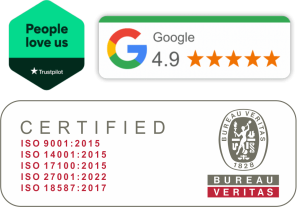Data Annotation for AI
Professional data annotation for artificial intelligence
– text, image, audio, video.


WHY CHOOSE OUR DATA ANNOTATION SERVICES
What is data annotation, and how can you start your own project?
Data is the fuel that powers technology. However, raw data alone is not enough. In order for it to be useful to an AI model, it needs to be properly prepared. This is where data annotation comes in.
In this article, you’ll learn:
• what data annotation actually is,
• what types of annotation exist,
• how to plan a successful annotation project,
• what to watch out for.
What is data annotation?
In simple terms, data annotation is the process of labelling or tagging data in a way that makes it understandable for artificial intelligence systems. Imagine you have thousands of images of rabbits and hamsters, but the computer doesn’t know which is which. To help the algorithm learn, you have to tell it by marking one image as a rabbit, and another as a hamster. Annotation is an essential step in preparing data for training machine learning models or AI systems. It gives the machine context and allows it to understand what it’s processing.


Got the data but missing annotation? We’ve got you covered – accurately, quickly, and with quality control.

Why does data annotation matter?
Imagine giving a translator a document with no punctuation, formatting or cultural context. This is how a machine ‘feels’ when it receives unstructured, raw data.
Annotation acts like a translation in that it tells the algorithm what something means, what to focus on, and how to interpret images, sound or text.
The quality of your annotation directly impacts:
• the accuracy of your AI model,
• the decisions the system will make,
• the speed of implementation,
• the overall cost of the project.
What are the main types of annotation?
The type of annotation you choose depends on the kind of data you have and your project goals. Here are the most common types:
Text annotation
Used in chatbots, sentiment analysis, automatic translation, and more. You might annotate user intent, tone, named entities, or product categories.
Example: Tagging the word “Amsterdam” as a city and “Lufthansa” as a company name.
Image annotation
Useful in object recognition systems, autonomous vehicles, medical imaging, or e-commerce.
Audio annotation
Applies to voice assistants, speech recognition, or sound detection. You might label speech segments, background noise, speaker emotion, or language.
Video annotation
Combines image and audio annotation over time, labelling objects in motion, tracking behaviours and detecting actions.
How to prepare a data annotation project?
A well-structured annotation project is half the battle. Here are the key steps:
1. Define your goal
Start with the question: Why do I need annotation? Are you trying to build a better recommendation engine, automate customer support, or improve visual search?
The clearer your goal, the easier it will be to define the right approach and tools.
2. Collect your data
You can’t annotate anything if you don’t have the data. Get all the files you need – texts, recordings, images, videos. Make sure they’re high-quality and legally compliant (e.g. GDPR, if applicable).
3. Choose tools and platforms
There are loads of annotation tools out there – some are open-source, some are commercial, some have automation features and some involve a human in the loop. Choose one that suits your needs.
4. Create annotation guidelines
This is your instruction manual for annotators. It should clearly explain:
- what to annotate,
- how to do it (e.g., boxes, codes, labels),
- what to avoid,
- include correct and incorrect examples.
Good documentation = better consistency and fewer errors. A video tutorial with a short demo showing how to perform the annotation might also be helpful.
5. Build an annotation team (or Outsource It)
You can create your own internal annotation team or partner with a specialized provider. Keep in mind that annotation is time-consuming and requires precision.
If you want speed and quality, outsourcing to an experienced agency may be your best bet.
A good option is also to build a team consisting of people from your organization and an external company.
6. Implement quality control (QA)
Not every annotation will be perfect on the first try. That’s why quality assurance is essential: random checks, peer reviews, corrections, annotator feedback. This ensures your data is actually usable and reliable.
What to watch out for?
- Vague project goals – without a clear objective, it’s hard to define success.
- Unclear instructions – lead to inconsistent and poor-quality annotations.
- No quality assurance – you risk training your model on flawed data.
- Too few examples – your AI model won’t learn properly if the dataset is too limited.
Why can a translation agency help with annotation?
You might be wondering what a translation agency has to do with data annotation.
A lot, actually. Language professionals are trained in precision, cultural nuance, and working with multilingual content. This makes them ideal for text annotation, especially in projects involving:
- natural language processing (NLP),
- multilingual chatbots,
- sentiment analysis across different markets,
- OCR and machine translation systems.
If you’re working with datasets in multiple languages or cultural contexts, you’ll benefit from a partner who understands both language and AI.
Ready to start your annotation project?
If you’ve already got data and want to make the most of it in your AI project, we’re here to help. From project planning and data annotation to quality assurance and delivery, we’ve got you covered.
Let’s talk! Contact us today to turn your raw data into actionable, AI-ready content.
Summary
Data annotation is a crucial step in developing effective AI-based solutions. Whether you’re working on a chatbot, image recognition system, sentiment analysis, or machine translation – you need data that “speaks the language” of your algorithm.
At Skrivanek, we combine linguistic expertise, precision, and technological know-how to deliver data that’s perfectly prepared for training AI and machine learning models. We support multiple languages, various data types (text, audio, image, video), and over 100 file formats. Every project is handled with a strong focus on quality, consistency, and data security.
If you value a professional approach, flexible collaboration, and real technological support – we’re here to help. Turn raw data into real business value with the help of Skrivanek’s annotation experts.
